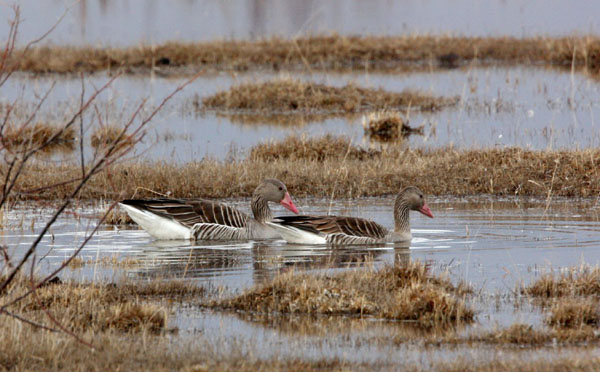Anser anser
IUCN
LCBasic Information
Scientific classification
- name:Anser anser
- Scientific Name:Wild goose, sand goose, gray waist goose, red bill goose, sand goose, yellow bill gray goose,Anser anser,Greylag Goose
- Outline:Waterfowl
- Family:Anseriformes
Vital signs
- length:70-90cm
- Weight:2.5-4kg
- lifetime:17years
Feature
The body is large and obese, with a long neck.
Distribution and Habitat
It breeds in most parts of the north, overwintering in suitable waters throughout the south, and rarely overwintering in Taiwan Island. It breeds in the temperate regions of Eurasia and the margins of the Tibetan Plateau, and overwinters in the southern part of the distribution.
It mainly lives in freshwater waters with aquatic plants, and integrates several to thousands of groups in the non-breeding period, living in grasslands, lakes, rivers, swamps, farmland and reservoirs, foraging in shallow water areas, and rarely mixing with other geese and ducks. It is the ancestor of European domestic geese.
Appearance
The whole body is grayish-brown with white and black-brown fine lines, the head, chest and lower abdomen are lighter in color, the lower abdomen has no black spots, and the buttocks and tail are covered with white feathers. Iris dark brown, beak pink, feet pink.
Details
Gray geese move in groups, usually consisting of tens, hundreds, or even thousands, except during breeding, especially during migration. He is flexible in walking on the ground, agile in action, and often stands on one foot when resting. Swimming and diving are good, but can not last long, rarely dive. Action is extremely cautious and cautious, vigilance is very high, especially when the group of foraging and resting together, there are often one or several gray geese as guards, do not eat, do not sleep, vigilant elongation of the neck, observing the four sides, once found that the enemy is near, they first take off, and then other members fly away.

They feed mainly during the day and rest at night. Often family groups or small groups of several families that feed together. In the early morning, before the sun comes out, the group flies to the feeding ground to feed, and then flies to the more sheltered places in other waters to rest, until sunset and dusk. In winter, when there is no disturbance, usually feeding and resting are in the same place, and the feeding ground is mostly on the shore of the waters rich in plants, grasslands, farmlands, wastelands and shallow waters. The food is mainly plant food such as leaves, roots, stems, buds, fruits and seeds of various aquatic and terrestrial plants, and sometimes snail, shrimp, insects and other animal food; During migration and in winter, they also eat scattered crop seeds and seedlings.
From the end of March to the beginning of April, groups of gray geese migrate from the southern wintering ground to Heilongjiang, Inner Mongolia, Gansu, Qinghai, Xinjiang and other northern regions of China to breed. At the end of September, groups migrate to the southern China to winter. A large number of gray geese migrate from the beginning of October to the end of October, and a few continue until the beginning of November. A large group of 3,000 animals was seen in the grasslands of western Jilin Province from mid-October to the end of October 1992. When flying, the two wings flap slowly, which is somewhat awkward, but more powerful, and in no hurry, flying slowly, in a single column or "V" formation. Flying at a high altitude, they usually migrate at night and rest and forage during the day. Sometimes it is called while flying, and the song is loud, clear and high.
Generally 2-3 years of sexual maturity, but there are less than 2 years of male birds began to chase females and drive other males, and began to form pairs. Breeding season from April to June. Nest building usually begins shortly after arrival at the breeding grounds. The nesting environment is mostly remote, inaccessible water side grass or reeds, but also on islands, grasslands and marshes. Most nests are built in pairs or small groups, and sometimes nests are especially concentrated in some places with good nesting environments, and the nest spacing is only about 10 meters. Male and female nest together. The nest is made of reeds, rushes and other hay, and is lined with feather around and inside. Each litter lays 4-8 eggs, usually 4-5 eggs. Egg white with orange-yellow spots, the size is 84.5-90.5 mm ×60-63.2 mm, weighing 156-178 grams. Eggs are laid from early to late April, usually 1 per day. After the eggs are laid, the eggs are incubated, which is borne by the female bird alone, and the male bird is guarded near the nest. The incubation period is 27-29 days. The chicks hatched from early to late May, and in mid-June the adults concentrated on moulting in the remote, unfrequented water side reeds.

Grey geese have a large population in China, especially the wintering population. Historically, grey geese were the traditional hunting objects in China together with red geese, bean geese and white-fronted geese. Due to excessive hunting and the deterioration of the wintering environment, the population has declined greatly. In 1990, the World Waterfowl Research Bureau (IWRB) organized a survey of Asian midwinter waterbirds, only 4,906 were counted in China. From mid-October to the end of October 1992, more than 3,000 gray geese were seen in the grasslands of western Jilin Province, and the population of Chinese gray geese is estimated to have recovered somewhat.
In October 2020, the State Forestry and Grass Administration issued the Notice on Regulating the Scope of Classified Management of fasting Wild Animals, prohibiting breeding activities for the purpose of consumption of gray geese, and guiding farmers to stop breeding except for special circumstances such as the retention of appropriate provenance.








